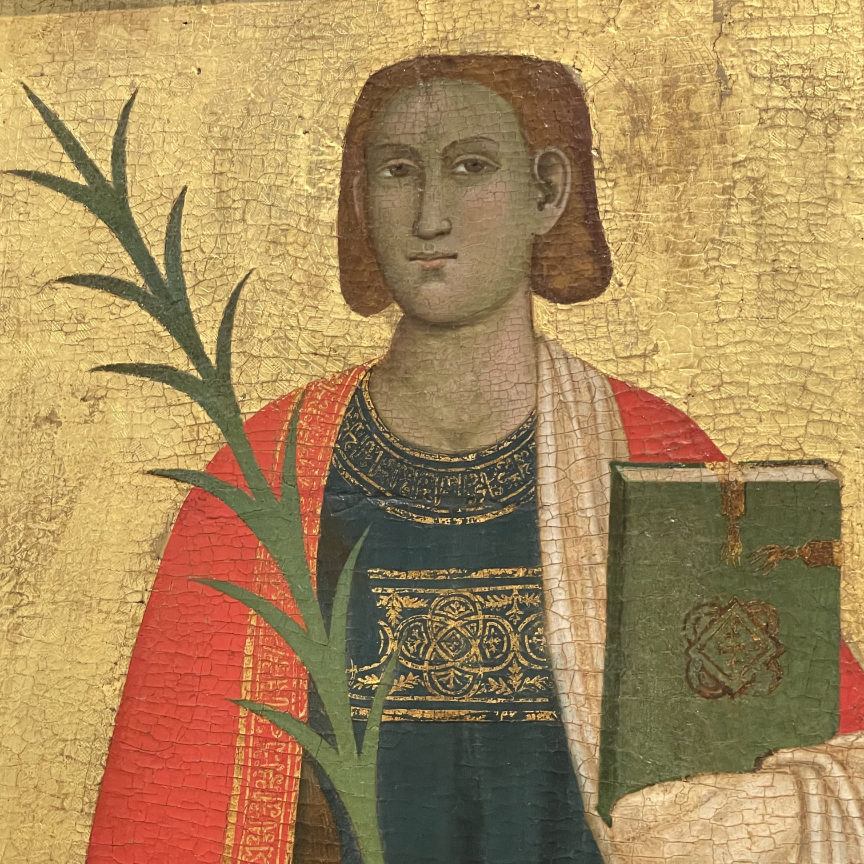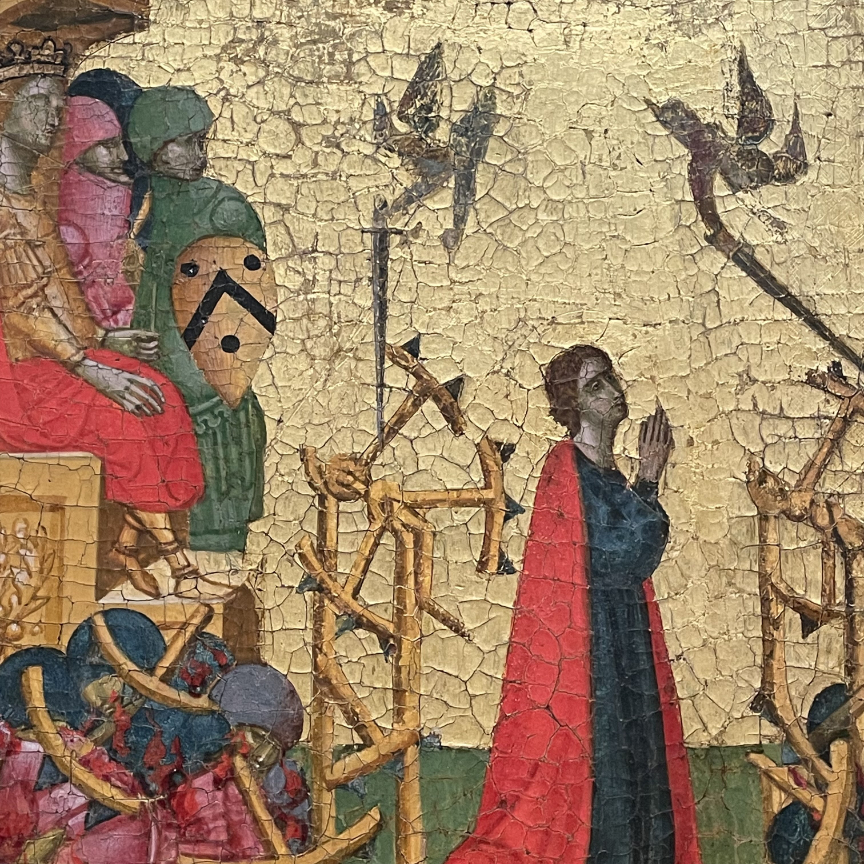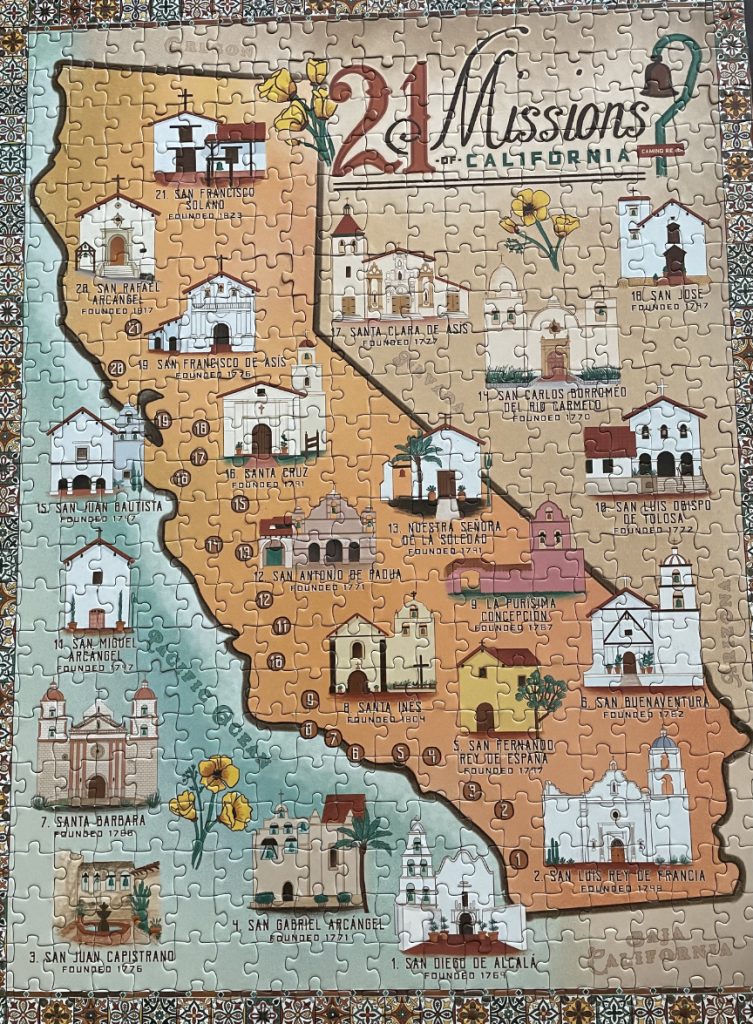By Wendy S. Loquasto

On a recent trip to Santa Barbara, California, I saw paintings of Saint Catherine of Alexandria at the Getty Center, and I visited the Old Mission Santa Barbara, where I purchased a puzzle of the 21 Spanish missions founded along the El Camino Real, including Mission San Juan Capistrano. Serendipity thus reminded me that I intended to write one more article about the patron saints of lawyers. As a female appellate lawyer who presents oral argument, I am pleased to write about St. Catherine, who is known for her debating skills. As a bird lover, the miracle of the swallows at Mission San Juan Capistrano prompted me to write of St. John.
St. Catherine of Alexandria (circa AD 287-305)

Unfortunately, there are no surviving primary sources attesting to Saint Catherine’s existence, but the stories about her and her inclusion among the Fourteen Holy Helpers[1] confirms her existence and life of heroic virtue.[2]
Catherine was born to a noble pagan family (perhaps as a princess) around AD 287 in Alexandria, Egypt, which was then one of the finest cities in the world and a center of learning and culture. She was an avid scholar, and although a teenager, she was very intelligent and gifted. Around age 14, Catherine experienced a vision of the Virgin Mary and baby Jesus and she decided to become a Christian.[3]
When Roman Emperor Maxentius,[4] who ruled before Christianity was legalized in 313, began persecuting Christians, 18-year-old Catherine visited him to denounce his cruelty. Rather than order her execution, Maxentius summoned 50 orators and philosophers to debate her. Catherine, moved by the Holy Spirit, eloquently defended her faith. Her words were so compelling that many of those pagan listeners converted to Christianity, as did 200 soldiers and members of the emperor’s family, and they were all martyred.[5]
Unable to defeat her rhetorically or to intimidate her into giving up her Christian belief, Emperor Maxentius ordered Catherine to be scourged (whipped) and imprisoned, but still she did not abandon her faith. Word of her arrest and the power of her faith quickly spread and hundreds of people visited her. According to some legends, the emperor’s own wife, Valeria Maximilla, was converted by Catherine.[6]
Emperor Maxentius made a final attempt to persuade Catherine to abandon her faith by proposing an alliance or marriage to her, which would have made her very powerful. But Catherine refused, saying she was married to Jesus Christ.[7]
The emperor angrily ordered her to be executed on a breaking wheel, which is an ancient form of torture whereby the person’s limbs were threaded among the spokes of a wheel and their bones were shattered by an executioner with a heavy rod.[8]
When Catherine was presented before the wheel, she touched it and a miracle occurred that caused the wheel to shatter.[9]
Unable to torture her to death, Emperor Maxentius ordered her beheaded and she was martyred for her faith. Tradition claims that angels took her body to Mount Sinai, and in the 6th century, Emperor Justinian ordered a monastery established in her name. Saint Catherine’s Monastery remains to this day and is one of the oldest in the world.[10]
St. Catherine was canonized pre-congregation. She became immensely popular during the Middle Ages and many chapels and churches were devoted to her. She and the other Holy Helpers were called on in prayer for protection against the “Black Plague.” She was also reported to be one of the divine advisors to Saint Joan of Arc.[11] She is invoked as the patroness of students, teachers, librarians, and lawyers.[12] Her feast day is November 25.
In 1969, Pope Paul VI issued a revised liturgical calendar from which many saints were removed, due mostly to the very sparse amount of actual biographical material that remained in existence, and Catherine was among those saints. However, after visiting Saint Catherine’s Monastery on Mount Sinai in 2002, Pope John Paul II restored St. Catherine to the Universal Roman Calendar.[13]
St. John of Capistrano (AD 1385 – 1456)

Saint John was born in AD 1385 to nobility in Italy, the son of a German knight who was drafted to serve in the wars in Naples and a young woman of great piety from Capistrano. His father died when he was young and his mother taught him primarily Latin and then sent him to the University of Perugia. He studied civil and canon law with great success, and became a lawyer in Naples. He gained such an admirable reputation that King Ladislas of Naples frequently called upon him for advice.[14]
John married the daughter of a prominent citizen in Perugia and in 1412, when he was not yet 30 years old, King Ladislas made him Governor of Perugia. These were troubled times in the region and John worked to eradicate corruption and bribery. The Malatesta family controlled several neighboring cities, and war broke out between Perugia and Rimini. John attempted to broker a peace, but the Malatestas seized him and cast him into prison.[15]
While in prison, John had a vision. Saint Francis of Assisi, surrounded with light, appeared to him and invited him to enter his order. Once freed, his marriage was annulled on the basis that it had never been consummated, and he was released to join the Franciscans. John studied theology and made an unusual penance, sitting backwards on a donkey parading through the streets of Perugia wearing a hat listing his sins.[16] He was ordained in 1420 and began his apostolic ministry in 1425.[17]J
ohn collaborated with his mentor, Saint Bernardine of Siena, in reforming the Franciscans, who had become bitterly divided. They promoted a return to more strict discipline for members of the order, and John frequently wrote of papal supremacy over councils. These reforms led to him, St. Bernardine, and other observant friars being accused of heresy in 1429. John defended their cause and they were acquitted.[18]
Friar John traveled all over Italy and Europe converting many to Christianity and he became so popular that huge crowds would gather to hear him speak. Pulpits would be erected in city plazas and all traffic would be stopped to accommodate him.[19] Pope Pius II, who knew John, described him as short of stature and nothing but skin on his bones, but always gay and indefatigable, and he wrote: “Every day he preaches before twenty and even thirty thousand persons, clarifying the thorniest problems, pleasing the simple as much as the learned.”[20]
The popes called upon Friar John frequently for various commissions as a papal legate to kingdoms throughout Europe. John’s final years are not without controversy, as he was summoned by Pope Callixtus III to lead a crusade against the Turks. After Mehmed II captured Constantinople in 1453, he began an invasion of Hungary, advancing to the gates of Belgrade. John, armed with only a crucifix and Christian banner, led a wing of the Christian army. His speech inspired the despairing army to conquer the Turks or die as martyrs, and Mehmed’s superior forces fled in wild confusion.[21]
The stresses of his active and austere life and the exhaustion of the war weakened him. John fell ill to the bubonic plague and died in the Franciscan convent of Illok in Hungary (now modern-day Croatia) on October 23, 1456, at the age of 71. After the usual research on his past and miracles, he was canonized by Pope Benedict XIII in 1724.[22] His feast day is October 23 and he is considered the patron saint not only of lawyers, but also of jurists and military chaplains.
St. John of Capistrano has a unique presence in the United States as well. In 1776, Spanish Franciscans built Mission San Juan Capistrano in southern California. The miracle of the swallows takes place each year at the Mission on March 19, when the swallows return from wintering in South America. The swallows’ legend follows:
One day, while walking through town, Father O’Sullivan saw a shopkeeper, broomstick in hand, knocking down the conically shaped mud swallow nests that were under the eaves of his shop. The birds were darting back and forth through the air squealing over the destruction of their homes.
“What in the world are you doing?” O’Sullivan asked.
“Why, these dirty birds are a nuisance and I am getting rid of them!” the shopkeeper responded.
“But where can they go?”
“I don’t know and I don’t care,” he replied, slashing away with his pole. “But they’ve no business here, destroying my property.”
Father O’Sullivan then said, “Come on swallows, I’ll give you shelter. Come to the Mission. There’s room enough there for all.”
The very next morning, Father O’Sullivan discovered the swallows busy building their nests outside Father Junípero Serra’s Church.[[23]]
Other Patron Saints of Lawyers
There are others who are said to be patron saints of lawyers, including: Saint Raymond of Penyafort (AD 1175 – 1275), who studied law at the University of Bologna and who later compiled a five-volume collection of canon law in 1230 known as the Decretals of Gregory IX; Saint Mark the Evangelist (circa 1st century – AD 68), who wrote the Gospel of Mark, which is a primary, direct, concise, and persuasive writing about the message of Christ; and Saint Nicholas or Nikolaos of Myra (circa AD 280 – 343), the legendary Santa Claus, who was known not only for his charity, but also for his strong sense of justice, including accounts of him saving innocent men from beheadings.[24] I leave further reading and research on these others to you.
[1].The Fourteen Holy Helpers are a group of ancient saints invoked with special confidence because they have proven themselves efficacious helpers in adversity and difficulties. They were invoked as a group when the “Black Plague” devastated Europe from 1346 to 1349. The group devotion began in Germany, near the town of Bad Staffelsein, where a chapel and basilica were built and which is a famous place of pilgrimage. Fourteen Holy Helpers, CatholicSaints.Info (Apr. 29, 2020), https://catholicsaints.info/fourteen-holy-helpers/; Fourteen Holy Helpers, The Fourteen Holy Helpers (Parish Church), https://14hh.org/parish-about-us/14holyhelpers/ (last visited Oct. 8, 2021). Saint Barbara, for whom Santa Barbara is named, is also one of the Holy Helpers.
[2].St. Catherine of Alexandria, Catholic Online, Saints & Angels, https://www.catholic.org/saints/saint.php?saint_id=341 (last visited Oct. 8, 2021).
[3].Id.; and see St. Catherine of Alexandria, CNA – Catholic News Agency, https://www.catholicnewsagency.com/saint/st-catherine-of-alexandria-398 (last visited Oct. 8, 2021).
[4].Marcus Aurelius Valerius Maxentius (circa 283 – October 28, 312).
[5].St. Catherine of Alexandria, Catholic Online, Saints & Angels, https://www.catholic.org/saints/saint.php?saint_id=341 (last visited Oct. 8, 2021); Saint Catherine of Alexandria, Franciscan Media, Saint of the Day (Nov. 25, 2020), https://www.franciscanmedia.org/saint-of-the-day/saint-catherine-of-alexandria; Bishop David M. O’Connell, C.M., “‘Holy Helper’ St. Catherine of Alexandria known for powerful persuasion,” Diocese of Trenton (New Jersey) (Mar. 25, 2019), https://dioceseoftrenton.org/news/holy-helper-st-catherine-of-alexandria.
[6].St. Catherine of Alexandria, Catholic Online, Saints & Angels, https://www.catholic.org/saints/saint.php?saint_id=341 (last visited Oct. 8, 2021).
[7].Id.; see also St. Catherine of Alexandria, CNA – Catholic News Agency, https://www.catholicnewsagency.com/saint/st-catherine-of-alexandria-398 (last visited Oct. 8, 2021); Bishop David M. O’Connell, C.M., “‘Holy Helper’ St. Catherine of Alexandria known for powerful persuasion,” Diocese of Trenton (New Jersey) (Mar. 25, 2019), https://dioceseoftrenton.org/news/holy-helper-st-catherine-of-alexandria.
[8].St. Catherine of Alexandria, Catholic Online, Saints & Angels, https://www.catholic.org/saints/saint.php?saint_id=341 (last visited Oct. 8, 2021).
[9].Id.; see also St. Catherine of Alexandria, CNA – Catholic News Agency, https://www.catholicnewsagency.com/saint/st-catherine-of-alexandria-398 (last visited Oct. 8, 2021); Bishop David M. O’Connell, C.M., “‘Holy Helper’ St. Catherine of Alexandria known for powerful persuasion,” Diocese of Trenton (New Jersey) (Mar. 25, 2019), https://dioceseoftrenton.org/news/holy-helper-st-catherine-of-alexandria.
[10].St. Catherine of Alexandria, Catholic Online, Saints & Angels, https://www.catholic.org/saints/saint.php?saint_id=341 (last visited Oct. 8, 2021); Saint Catherine of Alexandria, Franciscan Media, Saint of the Day (Nov. 25, 2020), https://www.franciscanmedia.org/saint-of-the-day/saint-catherine-of-alexandria.
[11].Saint Catherine of Alexandria, CatholicSaints.Info (Apr. 25, 2021), https://catholicsaints.info/saint-catherine-of-alexandria/.
[12].Saint Catherine of Alexandria, Franciscan Media, Saint of the Day (Nov. 25, 2020), https://www.franciscanmedia.org/saint-of-the-day/saint-catherine-of-alexandria.
[13].Bishop David M. O’Connell, C.M., “‘Holy Helper’ St. Catherine of Alexandria known for powerful persuasion,” Diocese of Trenton (New Jersey) (Mar. 25, 2019), https://dioceseoftrenton.org/news/holy-helper-st-catherine-of-alexandria.
[14].Saint John of Capestrano, San Juan Capistrano Historical Society (Apr. 12, 2021), https://sjchistoricalsociety.com/history/saint-john-of-capestrano/; Saint John of Capistrano (St. Jean de Capistran), Roman-Catholic-Saints.com, https://www.roman-catholic-saints.com/saint-john-of-capistrano.html (last visited Oct. 7, 2021).
[15].Saint John of Capestrano, San Juan Capistrano Historical Society (Apr. 12, 2021), https://sjchistoricalsociety.com/history/saint-john-of-capestrano/; Saint John of Capistrano (St. Jean de Capistran), Roman-Catholic-Saints.com, https://www.roman-catholic-saints.com/saint-john-of-capistrano.html (last visited Oct. 7, 2021); Gerald Korson, “Legacy of St. John of Capistrano: Fifteenth-century Franciscan is patron of jurists and military chaplains,” Knights of Columbus (Oct. 22, 2020), www.kofc.org/en/news-room/articles/legacy-of-st-john-of-capistrano.html.
[16]. Gerald Korson, “Legacy of St. John of Capistrano: Fifteenth-century Franciscan is patron of jurists and military chaplains,” Knights of Columbus (Oct. 22, 2020), www.kofc.org/en/news-room/articles/legacy-of-st-john-of-capistrano.html; Saint John of Capistrano (St. Jean de Capistran), Roman-Catholic-Saints.com, https://www.roman-catholic-saints.com/saint-john-of-capistrano.html (last visited Oct. 7, 2021).
[17].Saint John of Capistrano, Loyola Press, https://www.loyolapress.com/catholic-resources/saints/saints-stories-for-all-ages/saint-john-of-capistrano/ (last visited Oct. 8, 2021); Saint John of Capistrano (St. Jean de Capistran), Roman-Catholic-Saints.com, https://www.roman-catholic-saints.com/saint-john-of-capistrano.html (last visited Oct. 7, 2021).
[18].Billy Jacobs, “Saint John of Capistrano,” The Path to Sainthood (Oct. 22, 2020), https://www.thepathtosainthood.com/post/saint-john-of-capistrano; and see Saint John of Capistrano, Loyola Press, https://www.loyolapress.com/catholic-resources/saints/saints-stories-for-all-ages/saint-john-of-capistrano/ (last visited Oct. 8, 2021); Gerald Korson, “Legacy of St. John of Capistrano: Fifteenth-century Franciscan is patron of jurists and military chaplains,” Knights of Columbus (Oct. 22, 2020), www.kofc.org/en/news-room/articles/legacy-of-st-john-of-capistrano.html.
[19].Saint John of Capestrano, San Juan Capistrano Historical Society (Apr. 12, 2021), https://sjchistoricalsociety.com/history/saint-john-of-capestrano/.
[20].Id.
[21].Id; Saint John of Capistrano (St. Jean de Capistran), Roman-Catholic-Saints.com, https://www.roman-catholic-saints.com/saint-john-of-capistrano.html (last visited Oct. 7, 2021).
[22].Saint John of Capistrano (St. Jean de Capistran), Roman-Catholic-Saints.com, https://www.roman-catholic-saints.com/saint-john-of-capistrano.html (last visited Oct. 7, 2021). Other sources state that he was canonized as early as 1630, 1690, or 1694, but these dates may refer to his beatification.
[23].Father St. John O’Sullivan, “The Legend of the Cliff Swallows of Capistrano,” Capistrano Nights, https://www.missionsjc.com/wp-content/uploads/2021/07/Swallows-Story.pdf (last visited Oct. 8, 2021).
[24].See Saint Raymond of Peñafort, Franciscan Media, Saint of the Day (Jan. 7, 2021), https://www.franciscanmedia.org/saint-of-the-day/saint-raymond-of-penafort; St. Mark Evangelist: Patron of Lawyers and Prisoners, Catholic News World (Apr. 24, 2019), http://www.catholicnewsworld.com/2019/04/saint-april-25-st-mark-evangelist.html; Theresa Doyle-Nelson, “Why is St. Mark the Patron Saint of Lawyers?”, The Hill Country Hermit, http://theresadoyle-nelson.blogspot.com/2016/04/why-is-st-mark-patron-saint-of-lawyers.html (last visited Oct. 8, 2021); St. Nicholas, Catholic Online, https://www.catholic.org/saints/saint.php?saint_id=371 (last visited Oct. 8, 2021); Who was St. Nicholas?, Campbell University News, Campbell University, https://news.campbell.edu/articles/who-was-st-nicholas/ (last visited Oct. 8, 2021).


